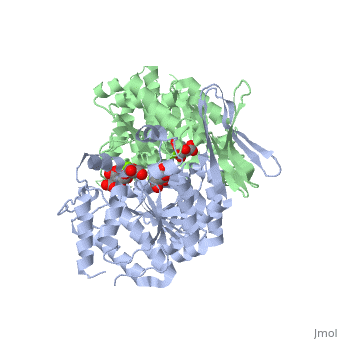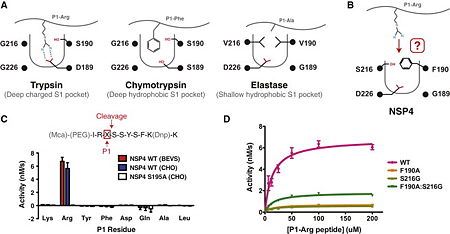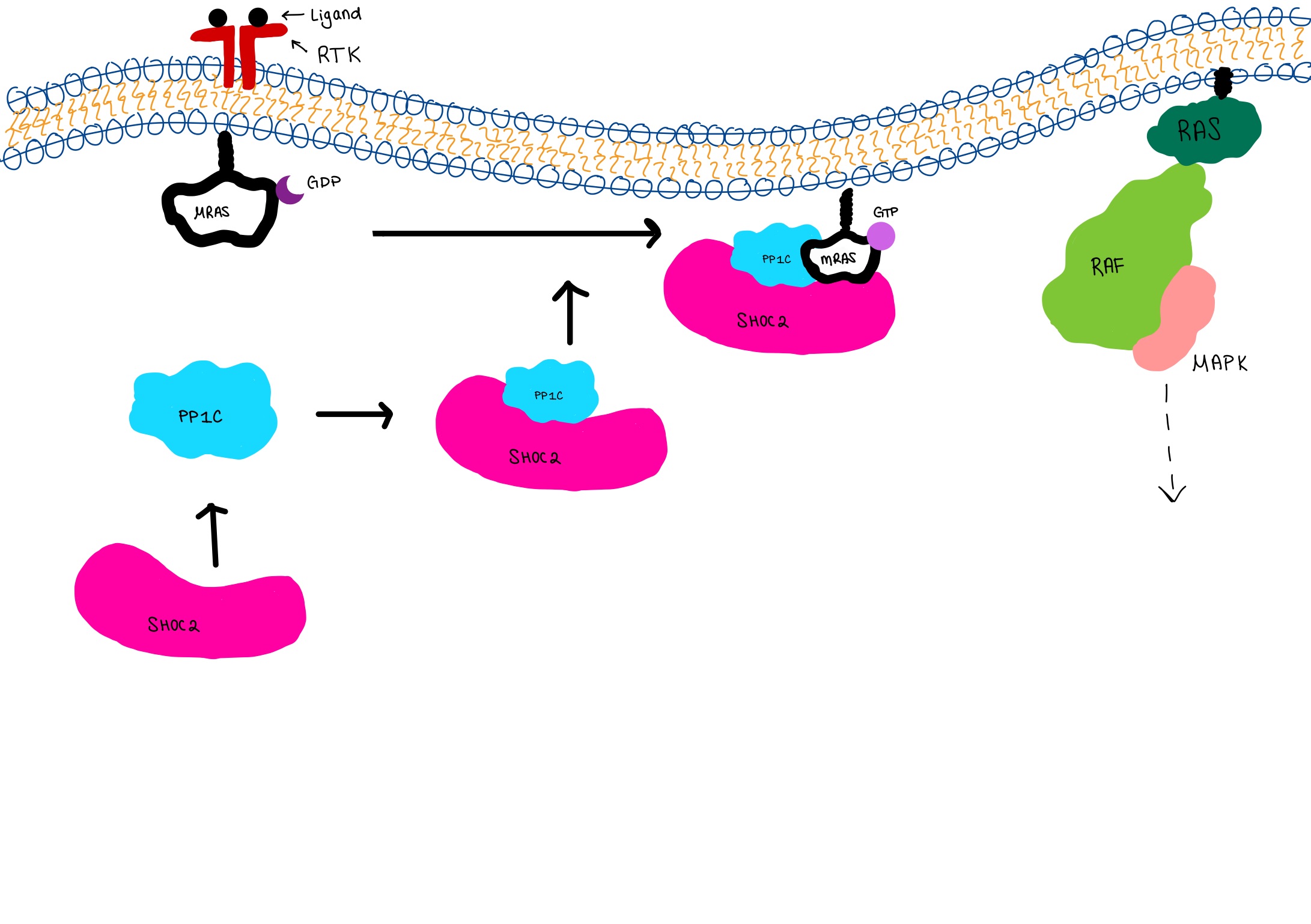Isocitrate dehydrogenase
From Proteopedia
(Difference between revisions)
| (34 intermediate revisions not shown.) | |||
| Line 1: | Line 1: | ||
| - | + | <StructureSection load='2uxr' size='350' side='right' scene='' caption='Isocitrate dehydrogenase dimer complex with isocitrate, glycerol and Mg+2 ion (green) (PDB code [[2uxr]])'> | |
| + | ==Introduction== | ||
| + | [[Isocitrate dehydrogenase]] (IDH) is an enzyme that is used during the third step of the [[Citric Acid Cycle|citric acid cycle]]. This biological reaction is an essential process that is used to create molecules that are used for cellular energy. In this step it catalyzes the oxidative decarboxylation of isocitrate meaning that CO2 is released from the isocitrate. In addition coenzyme [http://en.wikipedia.org/wiki/Nicotinamide_adenine_dinucleotide NAD]+ is converted to an [http://en.wikipedia.org/wiki/Nicotinamide_adenine_dinucleotide NADH]. This reaction results in an alpha-ketoglutarate molecule which is then moved on to the forth step of the citric acid cycle. In ''Escherichia coli'' the IDH is regulated by phosphorylation which is catalyzed by [[Isocitrate dehydrogenase kinase/phosphatase|IDH kinase/phosphatase (IDHK/P)]]. Human '''IDH1''' is cytoplasmic while '''IDH2''' is mitochondrial. See also:<br /> | ||
| + | *[[Krebs cycle carbons]] | ||
| + | *[[Krebs cycle importance]] | ||
| + | *[[Krebs cycle overview]] | ||
| + | *[[Krebs cycle reactions]] | ||
| + | *[[Citric Acid Cycle]] | ||
| + | *[[Krebs cycle step 3]] | ||
| - | [[Image:1sjs.png|left|200px|thumb|Crystal Structure of Isocitrate dehydrogenase, [[1sjs]]]][[Isocitrate dehydrogenase]] (IDH) is an enzyme that is used during the third step of the [[Citric Acid Cycle|citric acid cycle]]. This biological reaction is an essential process that is used to create molecules that are used for cellular energy. In this step it catalyzes the oxidative decarboxylation of isocitrate meaning that CO2 is released from the isocitrate. In addition coenzyme [http://en.wikipedia.org/wiki/Nicotinamide_adenine_dinucleotide NAD]+ is converted to an [http://en.wikipedia.org/wiki/Nicotinamide_adenine_dinucleotide NADH]. This reaction results in an alpha-ketoglutarate molecule which is then moved on to the forth step of the citric acid cycle. In ''Escherichia coli'' the IDH is regulated by phosphorylation which is catalyzed by [[Isocitrate dehydrogenase kinase/phosphatase|IDH kinase/phosphatase (IDHK/P)]]. The images at the left and at the right correspond to one representative Isocitrate dehydrogenase, ''i.e.'' the crystal structure of Isocitrate dehydrogenase from ''Escherichia coli'' ([[1sjs]]). | ||
| - | |||
| - | {{TOC limit|limit=2}} | ||
==Structural Analysis== | ==Structural Analysis== | ||
Isocitrate dehydrogenase is SCOP classified as an alpha beta structure. Its secondary composition consists of mainly alpha helices and beta sheets which are arranged into three layer alpha beta alpha <scene name='Michael_nobbe_sandbox_2/Alpha_beta_sandwich/1'>sandwich structures.</scene>. The entire protein consists of two side by side sandwich structures that face opposite directions. This then causes the proteins two active sites to face opposite directions. These two groups make up the A and B subunits of isocitrate dehydrogenase.In human isocitrate dehydrogenase there are 4 subunits. | Isocitrate dehydrogenase is SCOP classified as an alpha beta structure. Its secondary composition consists of mainly alpha helices and beta sheets which are arranged into three layer alpha beta alpha <scene name='Michael_nobbe_sandbox_2/Alpha_beta_sandwich/1'>sandwich structures.</scene>. The entire protein consists of two side by side sandwich structures that face opposite directions. This then causes the proteins two active sites to face opposite directions. These two groups make up the A and B subunits of isocitrate dehydrogenase.In human isocitrate dehydrogenase there are 4 subunits. | ||
| Line 10: | Line 15: | ||
The active site of Isocitrate dehydrogenase binds the NAD+ or an NADP+ molecule as well as an Mg2+ or Ca2+(<scene name='Michael_nobbe_sandbox_2/Isocitrate_active_site/4'>Active Site</scene>). This metal ion seems to be essential for catalysis<ref>PMID:15173171</ref>. Side chains of Asp 279 form hydrogen bonds with Ser94 (Human isocitrate dehydrogenase). Isocitrate is able to bind to the active site using about 8 amino acids like tyrosine, serine, asparagine, arginine, arginine, arginine, tyrosine, and lysine<ref>PMID:17632124</ref>. Across species these are not perfectly conserved but they are replaced with residues of similar properties and also are found in similar areas of the protein. Below is a picture of Porcine Active site with all of its residuals and ligands. | The active site of Isocitrate dehydrogenase binds the NAD+ or an NADP+ molecule as well as an Mg2+ or Ca2+(<scene name='Michael_nobbe_sandbox_2/Isocitrate_active_site/4'>Active Site</scene>). This metal ion seems to be essential for catalysis<ref>PMID:15173171</ref>. Side chains of Asp 279 form hydrogen bonds with Ser94 (Human isocitrate dehydrogenase). Isocitrate is able to bind to the active site using about 8 amino acids like tyrosine, serine, asparagine, arginine, arginine, arginine, tyrosine, and lysine<ref>PMID:17632124</ref>. Across species these are not perfectly conserved but they are replaced with residues of similar properties and also are found in similar areas of the protein. Below is a picture of Porcine Active site with all of its residuals and ligands. | ||
| - | + | [[Image:Active site.jpg|left|450px|thumb]] | |
| - | [[Image:Active site. | + | {{Clear}} |
| - | + | Mg+ ion (red) next to the ligand which is surrounded by the residues of the active site<ref>http://en.wikipedia.org/wiki/Isocitrate_dehydrogenase#cite_note-nfr154197.2F32-6</ref>. | |
| - | + | ||
| - | is surrounded by the residues of | + | |
==Function== | ==Function== | ||
| Line 25: | Line 28: | ||
[[Image:Mechanism.jpg]] | [[Image:Mechanism.jpg]] | ||
| - | + | {{Clear}} | |
| - | + | ||
| - | + | ||
The mechanism by which isocitrate is converted to alpha-ketoglutarate <ref>http://en.wikipedia.org/wiki/File:IDHcatalyticmechanism.jpg</ref> | The mechanism by which isocitrate is converted to alpha-ketoglutarate <ref>http://en.wikipedia.org/wiki/File:IDHcatalyticmechanism.jpg</ref> | ||
==Inhibition== | ==Inhibition== | ||
| - | < | + | <scene name='Isocitrate_dehydrogenase/Opening/1'>Structure of Isocitrate Dehydrogenase</scene> ([[1t01]]). |
This step an irreversible reaction. It must be carefully regulated to avoid depletion of isocitrate in the body. The reaction is started by substrate availability which are: isocitrate,Mg2+, NAD+ or NADP+. If these are not present than the process will not carry forward. The reaction is inhibited by the removal of NADH from the presence of the citric acid cycle. The product is also inhibited by ATP feedback. This feedback inhibition is a competitive inhibitor. Since the citric acid cycle is used to produce energy molecules (ATP), an abundance of product will shut down the cycle. | This step an irreversible reaction. It must be carefully regulated to avoid depletion of isocitrate in the body. The reaction is started by substrate availability which are: isocitrate,Mg2+, NAD+ or NADP+. If these are not present than the process will not carry forward. The reaction is inhibited by the removal of NADH from the presence of the citric acid cycle. The product is also inhibited by ATP feedback. This feedback inhibition is a competitive inhibitor. Since the citric acid cycle is used to produce energy molecules (ATP), an abundance of product will shut down the cycle. | ||
| Line 43: | Line 44: | ||
==Additional Resources== | ==Additional Resources== | ||
| - | + | * [[Citric Acid Cycle]] <br/> | |
| - | + | * [[Cancer]] | |
| - | + | * [[Krebs cycle step 3]] | |
==3D Structures of Isocitrate dehydrogenase== | ==3D Structures of Isocitrate dehydrogenase== | ||
| + | [[Isocitrate dehydrogenase 3D structures]] | ||
| - | + | </StructureSection> | |
| - | + | ||
| - | + | ||
| - | + | ||
| - | + | ||
| - | + | ||
| - | + | ||
| - | + | ||
| - | + | ||
| - | + | ||
| - | + | ||
| - | + | ||
| - | + | ||
| - | + | ||
| - | + | ||
| - | + | ||
| - | + | ||
| - | + | ||
| - | + | ||
| - | + | ||
| - | + | ||
| - | + | ||
| - | + | ||
| - | + | ||
| - | + | ||
| - | + | ||
| - | + | ||
| - | + | ||
| - | + | ||
| - | + | ||
| - | + | ||
| - | + | ||
| - | + | ||
| - | + | ||
| - | + | ||
| - | + | ||
| - | + | ||
| - | + | ||
| - | + | ||
| - | + | ||
| - | + | ||
| - | + | ||
| - | + | ||
| - | + | ||
| - | + | ||
| - | + | ||
| - | + | ||
| - | + | ||
| - | + | ||
| - | + | ||
| - | + | ||
| - | + | ||
| - | + | ||
| - | + | ||
| - | + | ||
| - | + | ||
| - | + | ||
| - | + | ||
| - | + | ||
| - | + | ||
| - | + | ||
| - | + | ||
| - | + | ||
| - | + | ||
| - | + | ||
| - | + | ||
| - | + | ||
| - | + | ||
| - | + | ||
=='''References'''== | =='''References'''== | ||
Current revision
| |||||||||||
References
- ↑ Xu X, Zhao J, Xu Z, Peng B, Huang Q, Arnold E, Ding J. Structures of human cytosolic NADP-dependent isocitrate dehydrogenase reveal a novel self-regulatory mechanism of activity. J Biol Chem. 2004 Aug 6;279(32):33946-57. Epub 2004 Jun 1. PMID:15173171 doi:10.1074/jbc.M404298200
- ↑ Fedoy AE, Yang N, Martinez A, Leiros HK, Steen IH. Structural and functional properties of isocitrate dehydrogenase from the psychrophilic bacterium Desulfotalea psychrophila reveal a cold-active enzyme with an unusual high thermal stability. J Mol Biol. 2007 Sep 7;372(1):130-49. Epub 2007 Jun 19. PMID:17632124 doi:10.1016/j.jmb.2007.06.040
- ↑ http://en.wikipedia.org/wiki/Isocitrate_dehydrogenase#cite_note-nfr154197.2F32-6
- ↑ Xu X, Zhao J, Xu Z, Peng B, Huang Q, Arnold E, Ding J. Structures of human cytosolic NADP-dependent isocitrate dehydrogenase reveal a novel self-regulatory mechanism of activity. J Biol Chem. 2004 Aug 6;279(32):33946-57. Epub 2004 Jun 1. PMID:15173171 doi:10.1074/jbc.M404298200
- ↑ Xu X, Zhao J, Xu Z, Peng B, Huang Q, Arnold E, Ding J. Structures of human cytosolic NADP-dependent isocitrate dehydrogenase reveal a novel self-regulatory mechanism of activity. J Biol Chem. 2004 Aug 6;279(32):33946-57. Epub 2004 Jun 1. PMID:15173171 doi:10.1074/jbc.M404298200
- ↑ http://en.wikipedia.org/wiki/File:IDHcatalyticmechanism.jpg
- ↑ Figueroa ME, Abdel-Wahab O, Lu C, Ward PS, Patel J, Shih A, Li Y, Bhagwat N, Vasanthakumar A, Fernandez HF, Tallman MS, Sun Z, Wolniak K, Peeters JK, Liu W, Choe SE, Fantin VR, Paietta E, Lowenberg B, Licht JD, Godley LA, Delwel R, Valk PJ, Thompson CB, Levine RL, Melnick A. Leukemic IDH1 and IDH2 mutations result in a hypermethylation phenotype, disrupt TET2 function, and impair hematopoietic differentiation. Cancer Cell. 2010 Dec 14;18(6):553-67. Epub 2010 Dec 9. PMID:21130701 doi:10.1016/j.ccr.2010.11.015
Proteopedia Page Contributors and Editors (what is this?)
Michal Harel, Alexander Berchansky, David Canner, Michael Nobbe, Joel L. Sussman



